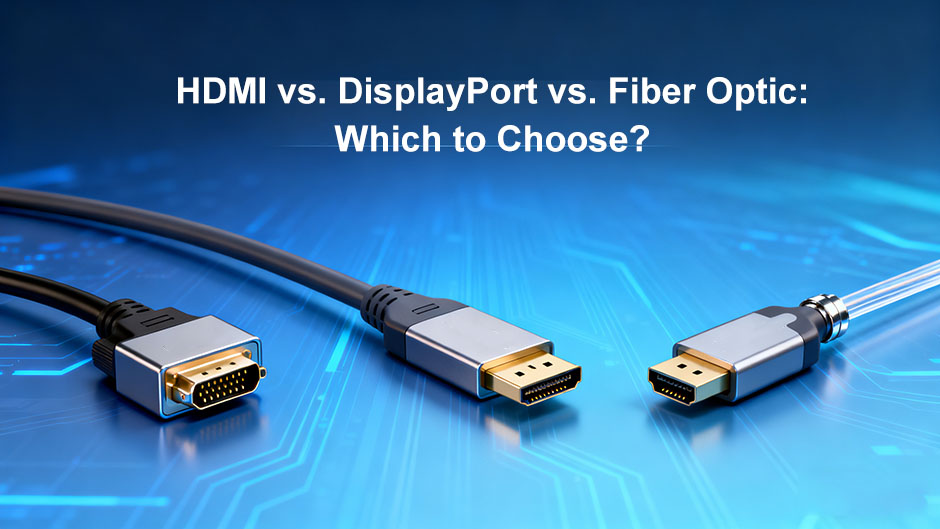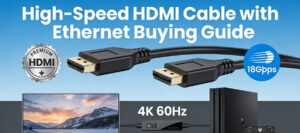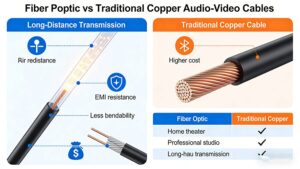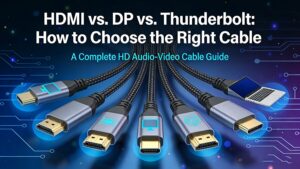Dans le monde des home cinémas, des configurations de jeu et des stations de travail professionnelles, le choix du bon câble de connexion peut faire ou défaire votre expérience audiovisuelle. HDMI, DisplayPortet câbles à fibres optiques dominent le marché, mais chacun d'entre eux se distingue dans des scénarios différents. Décortiquons le jargon pour trouver la solution qui vous convient le mieux.
Tous les câbles ne se valent pas. Ce tableau présente les différences essentielles entre les principales options :
| Fonctionnalité |
HDMI 2.1 (cuivre/fibre) |
DisplayPort 2.0 |
Fibre optique (HDMI/DP) |
| Largeur de bande maximale |
48 Gbps |
80 Gbps |
Jusqu'à 80 Gbps |
| Résolution supérieure/rafraîchissement |
8K@60Hz, 4K@120Hz |
16K@60Hz, 4K@240Hz |
Identique à la norme de base |
| Support HDR |
Dynamique (Dolby Vision IQ) |
HDR dynamique |
HDR sans compromis |
| Caractéristiques principales |
VRR, ALLM, eARC |
MST (affichage multiple), DSC |
Immunité aux interférences électromagnétiques, longue portée |
| Limite de longueur passive |
3-10m |
~4.5m |
N/A (actif uniquement) |
| Limite de longueur active |
Jusqu'à 300 m (fibre) |
Jusqu'à 100 m (optique) |
91-300m |
Le nom HDMI est connu de tous pour une bonne raison : il est partout. Des téléviseurs aux consoles de jeu (PS5/Xbox Series X) en passant par les projecteurs, presque tous les appareils grand public le prennent en charge.
Meilleur pour: Théâtres à domicile et jeux sur console.
HDMI 2.1’Les fonctions exclusives de la série VRR (taux de rafraîchissement variable) éliminent le déchirement de l'écran, tandis que le mode ALLM (auto low latency) maintient le délai de jeu en dessous de 5 ms. La prise en charge de l'eARC permet également de bénéficier du Dolby Atmos sans câbles audio supplémentaires.
À surveiller:
“Câbles ”HDMI 2.1-Certains ne prennent pas en compte des fonctions essentielles telles que la 4K@120Hz. S'en tenir aux modèles certifiés à large bande passante.
DisplayPort (DP) La norme VESA met l'accent sur la puissance brute, ce qui permet d'améliorer les performances des configurations à hautes performances. La norme DP 2.0 offre une bande passante de 80 Gbps, suffisante pour 16K@60Hz ou 4K@240Hz. .
Meilleur pour: Jeux sur PC, conception graphique et stations de travail multi-moniteurs. Sa technologie MST (Multi-Stream Transport) vous permet de chaîner 3 écrans ou plus à partir d'un seul port. Les utilisateurs professionnels apprécient la prise en charge de 128 canaux audio pour les configurations de studio. .
Compromis: Moins courant sur les téléviseurs et les consoles. Vous aurez besoin d'un adaptateur pour connecter des appareils DP à des écrans HDMI uniquement. .
La fibre optique n'est pas une “nouvelle” norme, c'est une "nouvelle" norme. Amélioration des matériaux pour HDMI/DP. Au lieu du cuivre, il utilise des signaux lumineux, ce qui le rend insensible aux interférences électromagnétiques (EMI). .
Meilleur pour: Les projecteurs, les grands home cinémas ou les installations de bureau de plus de 5 m. A
câble HDMI 2.1 en fibre peut transmettre 8K@60Hz sur 300m sans perte de signal, ce que les câbles en cuivre ne peuvent pas faire. .
Attraper: Coût plus élevé.
Câbles DP à fibres optiques, Bien qu'ils soient capables de fonctionner en 4K@144Hz, ils sont toujours vendus au prix fort. .
Vous n'êtes pas encore sûr ? Laissez-vous guider par votre cas d'utilisation :
Le débat “HDMI contre DP” ne signifie rien si vous utilisez des câbles obsolètes. Par exemple :
- HDMI 2.0 plafonne à 4K@60Hz - parfait pour les vieux téléviseurs, mais inutile pour les jeux en 4K. .
- DisplayPort 1.4 fonctionne pour 8K@60Hz, mais 2.0 est nécessaire pour 16K .
Faites toujours correspondre la version du câble aux ports de votre appareil (par exemple, câble HDMI 2.1 + moniteur HDMI 2.1) pour obtenir des performances optimales.
Vous avez des questions sur des configurations spécifiques ? Laissez un commentaire ci-dessous !







